#room addition cost in berkeley
Explore tagged Tumblr posts
Text
Experience an Oasis in the Heart of Lafayette at Springbrook Pool.
While Lafayette, California is popular for its lovely parks and outdoor recreational opportunities, a lesser-known attraction among locals is Springbrook Pool. Located in the heart of Lafayette, Springbrook Pool is the perfect place to relax and unwind while enjoying the sunshine.
Surrounded by lush greenery and towering trees, Springbrook Pool offers a peaceful oasis for visitors looking to escape the hustle and bustle of city life. With plenty of lounge chairs and shaded areas, it's the ideal spot to soak up some rays or catch up on some reading.
But Springbrook Pool isn't just a place to lounge around. The pool offers a range of activities to keep visitors of all ages entertained. For those looking to get some exercise, there are lap lanes available for swimming, as well as a diving board for those feeling a little more adventurous.
For the little ones, there's a designated kiddie pool where they can splash and play in shallow waters. And when it's time to refuel, visitors can head to the on-site snack bar for refreshments and snacks.
But what really sets Springbrook Pool apart from other public pools is its sense of community. The pool offers a range of classes and events throughout the summer, including swim lessons, water aerobics, and movie nights. It's a great place to meet new people and make lasting memories with friends and family.
And for those looking to make Springbrook Pool a regular part of their summer routine, there are season passes available for purchase. This makes it easy to visit the pool whenever you want, without having to worry about daily admission fees. But Springbrook Pool isn't just a summertime destination. The pool is heated and open year-round, offering a warm and cozy spot for swimming and relaxation even in the cooler months.
In addition to its amenities and activities, Springbrook Pool is also known for its friendly staff and welcoming atmosphere. From the lifeguards on duty to the snack attendants, everyone at Springbrook Pool goes out of their way to make sure that visitors enjoy their time there.
Furthermore, the pool is kept clean and well-maintained. The staff regularly checks the water quality to ensure safety and comfort for all visitors. With its prime location, family-friendly setting, and wide range of amenities, it's no wonder that Springbrook Pool has become a popular destination for locals in Lafayette.
To conclude, Springbrook Pool is the perfect place to escape the summer heat and relax in a peaceful oasis. With its sparkling water, lush greenery, and friendly staff, it’s no wonder why so many people have come to love this hidden gem in the heart of Lafayette. Whether you are looking for a place to swim or just take in the, Springbrook Pool is the perfect spot for a summertime getaway.
#ca#room addition#room addition contractors near me#adu unit#adu in berkeley#garage conversion in berkeley#room addition cost in berkeley#Lafayette
0 notes
Text
Our planet is choking on plastics. Some of the worst offenders, which can take decades to degrade in landfills, are polypropylene—which is used for things such as food packaging and bumpers—and polyethylene, found in plastic bags, bottles, toys, and even mulch.
Polypropylene and polyethylene can be recycled, but the process can be difficult and often produces large quantities of the greenhouse gas methane. They are both polyolefins, which are the products of polymerizing ethylene and propylene, raw materials that are mainly derived from fossil fuels. The bonds of polyolefins are also notoriously hard to break.
Now, researchers at UC Berkeley have come up with a method of recycling these polymers that uses catalysts that easily break their bonds, converting them into propylene and isobutylene, which are gases at room temperature. Those gases can then be recycled into new plastics.
“Because polypropylene and polyethylene are among the most difficult and expensive plastics to separate from each other in a mixed waste stream, it is crucial that [a recycling] process apply to both polyolefins,” the research team said in a study recently published in Science.
Breaking It Down
The recycling process the team used is known as isomerizing ethenolysis, which relies on a catalyst to break down olefin polymer chains into their small molecules. Polyethylene and polypropylene bonds are highly resistant to chemical reactions, because both of these polyolefins have long chains of single carbon-carbon bonds. Most polymers have at least one carbon-carbon double bond, which is much easier to break.
While isomerizing ethenolysis had been tried by the same researchers before, the previous catalysts were expensive metals that did not remain pure long enough to convert all of the plastic into gas. Using sodium on alumina followed by tungsten oxide on silica proved much more economical and effective, even though the high temperatures required for the reaction added a bit to the cost.
In both plastics, exposure to sodium on alumina broke each polymer chain into shorter polymer chains and created breakable carbon-carbon double bonds at the ends. The chains continued to break over and over. Both then underwent a second process known as olefin metathesis. They were exposed to a stream of ethylene gas flowing into a reaction chamber while being introduced to tungsten oxide on silica, which resulted in the breakage of the carbon-carbon bonds.
The reaction breaks all the carbon-carbon bonds in polyethylene and polypropylene, with the carbon atoms released during the breaking of these bonds ending up attached to molecules of ethylene. “The ethylene is critical to this reaction, as it is a coreactant,” researcher R.J. Conk, one of the authors of the study, told Ars Technica. “The broken links then react with ethylene, which removes the links from the chain. Without ethylene, the reaction cannot occur.”
The entire chain is catalyzed until polyethylene is fully converted to propylene, and polypropylene is converted to a mixture of propylene and isobutylene.
This method has high selectivity—meaning it produces a large amount of the desired product: propylene derived from polyethylene, and both propylene and isobutylene derived from polypropylene. Both of these chemicals are in high demand; propylene is an important raw material for the chemical industry, while isobutylene is a frequently used monomer in many different polymers, including synthetic rubber and a gasoline additive.
Mixing It Up
Because plastics are often mixed at recycling centers, the researchers wanted to see what would happen if polypropylene and polyethylene underwent isomerizing ethenolysis together. The reaction was successful, converting the mixture into propylene and isobutylene, with slightly more propylene than isobutylene.
Mixtures also typically include contaminants in the form of additional plastics. So the team also wanted to see whether the reaction would still work if there were contaminants. They experimented with plastic objects that would otherwise be thrown away, including a centrifuge and a bread bag, both of which contained traces of other polymers besides polypropylene and polyethylene. The reaction yielded only slightly less propylene and isobutylene than it did with unadulterated versions of the polyolefins.
Another test involved introducing different plastics, such as PET and PVC, to polypropylene and polyethylene to see if that would make a difference. These did lower the yield significantly. If this approach is going to be successful, then all but the slightest traces of contaminants will have to be removed from polypropylene and polyethylene products before they are recycled.
While this recycling method sounds like it could prevent tons upon tons of waste, it will need to be scaled up enormously for this to happen. When the research team increased the scale of the experiment, it produced the same yield, which looks promising for the future. Still, we’ll need to build considerable infrastructure before this could make a dent in our plastic waste.
“We hope that the work described … will lead to practical methods for … [producing] new polymers,” the researchers said in the same study. “By doing so, the demand for production of these essential commodity chemicals starting from fossil carbon sources and the associated greenhouse gas emissions could be greatly reduced.”
38 notes
·
View notes
Photo

Are you looking for Basement Remodeling Services near Berkeley CA? Handyman Services Of Oakland-Berkeley is offering Basement Remodeling Services.
https://remodelinghandymanberkeley.com/basement-remodeling-services-near-me/
Are you looking to unlock the hidden potential of your basement in Berkeley California? Look no further. Our Basement Remodeling Services of HANDYMAN SERVICES OF OAKLAND-BERKELEY is here to transform your underutilized space into a functional and inviting area.
Unleashing the Potential of Your Basement
The Many Faces of a Basement
Your basement holds immense potential. It can serve as a cozy family room, a home office, an entertainment area, or even a rental unit. The possibilities are endless, and our experts are well-equipped to help you decide on the perfect transformation for your basement.
Budget-Friendly Remodeling
Contrary to popular belief, basement remodeling doesn’t have to break the bank. We specialize in cost-effective solutions that bring your vision to life without draining your savings.
Enhancing Property Value
Investing in basement remodeling not only improves your living space but also increases the overall value of your home. It’s a win-win situation for homeowners in Berkeley California.
Our Services
Design and Planning
Every successful basement remodeling project begins with a well-thought-out design. Our experienced team will work closely with you to create a plan that aligns with your goals, making the most of the available space.
Waterproofing and Moisture Control
In the Berkeley California area, moisture control is crucial. We’ll ensure your basement remains dry and free from water-related issues.
Framing and Insulation
Proper framing and insulation are essential for a comfortable and energy-efficient basement. Our experts use the best materials and techniques to achieve this.
Flooring and Lighting
Choose from a wide range of flooring options and lighting designs to create the ambiance you desire. We’ll guide you through the selection process to achieve the best results.
Plumbing and Electrical
If your basement remodeling project involves adding a bathroom or kitchenette, our team is well-versed in plumbing and electrical work, ensuring functionality and safety.
Permits and Regulations
Navigating the permitting process in Berkeley California, can be challenging. We’ll handle all the paperwork, ensuring your project complies with local regulations.
FAQs
Q: What’s the average cost of basement remodeling in Berkeley California?
A: The cost varies depending on the scope of the project, but on average, you can expect to invest between $20,000 and $50,000.
Q: How long does it generally take to re-construct a basement?
A: The duration depends on the complexity of the project, but most basement remodels are completed within 4 to 8 weeks.
Q: Do I need to obtain permits for basement remodeling?
A: Yes, in most cases, you will need permits for basement remodeling in Berkeley California. Our team will work with you to secure the appropriate permits.
Q: Can I add a bedroom to my basement?
A: Yes, you can. Adding a bedroom to your basement is a popular choice among homeowners looking to increase living space.
Q: Is it possible to have a basement kitchenette?
A: Absolutely. Basement kitchenettes are a fantastic addition, providing convenience for various purposes.
Q: Will basement remodeling increase the resale value of my home?
A: Yes, a well-executed basement remodeling project can significantly boost your home’s resale value.
Basement Remodeling Services of Berkeley California: Transforming Your Space
Unlock the hidden potential of your basement with our expert Basement Remodeling Services of Berkeley California. From concept to completion, we’re dedicated to transforming your space into something extraordinary. Contact HANDYMAN SERVICES OF OAKLAND-BERKELEY today and embark on a journey to enhance both your living space and property value.
Contact Details: HANDYMAN SERVICES OF OAKLAND-BERKELEY Local Handyman Services in Berkeley, CA! (415) 874-8040 Monday to Sunday 7 am – 11 pm https://remodelinghandymanberkeley.com/ Berkeley California
Service Area:
Alameda ,Ca, Albany ,Ca, Berkeley ,Ca, Dublin ,Ca, Emeryville ,Ca, Fremont ,Ca, Hayward ,Ca, Livermore ,Ca, Newark ,Ca, Oakland (county seat) ,Ca, Piedmont ,Ca, Pleasanton ,Ca, San Leandro ,Ca, Union City ,Ca, Ashland ,Ca, Castro Valley ,Ca, Cherryland ,Ca, Fairview ,Ca, San Lorenzo ,Ca, Sunol ,Ca, Brentwood, Ca, Clayton ,Ca, Concord ,Ca, El Cerrito ,Ca, Hercules ,Ca, Lafayette ,Ca, Martinez (county seat) ,Ca, Oakley ,Ca, Orinda ,Ca, Pinole ,Ca, Pittsburg ,Ca, Pleasant Hill ,Ca, Richmond ,Ca, San Pablo ,Ca, San Ramon ,Ca, Walnut Creek ,Ca, Acalanes Ridge ,Ca, Alamo ,Ca, Alhambra Valley ,Ca, Bay Point ,Ca, Bayview ,Ca, Bethel Island ,Ca, Blackhawk ,Ca, Byron ,Ca, Camino Tassajara ,Ca, Castle Hill ,Ca, Clyde ,Ca, Contra Costa Centre ,Ca, Crockett ,Ca, Diablo ,Ca, Discovery Bay ,Ca, East Richmond Heights ,Ca, El Sobrante ,Ca, Kensington ,Ca, Knightsen ,Ca, Montalvin Manor ,Ca, Mountain View ,Ca, Norris Canyon ,Ca, North Gate ,Ca, North Richmond ,Ca, Pacheco ,Ca, Port Costa ,Ca, Reliez Valley ,Ca, Rodeo ,Ca, Rollingwood ,Ca, Saranap ,Ca, San Miguel ,Ca, Shell Ridge ,Ca, Tara Hills ,Ca, Vine Hill ,Ca
Zip Codes:
94501, 94502, 94706, 94707, 94708, 94709, 94710, 94720, 94703, 94704, 94705, 94552, 94546, 94568, 94555, 94536, 94538, 94539, 94541, 94542, 94544, 94545 94550, 94551, 94560 94601, 94602, 94603, 94605, 94606, 94607, 94608, 94609, 94610, 94611, 94612, 94613, 94618, 94619, 94621, 94566, 94588, 94577, 94578, 94579, 94580, 94586, 94587
0 notes
Text
William Lee Woollett, Architect
by Roger Jones, August 10, 2023
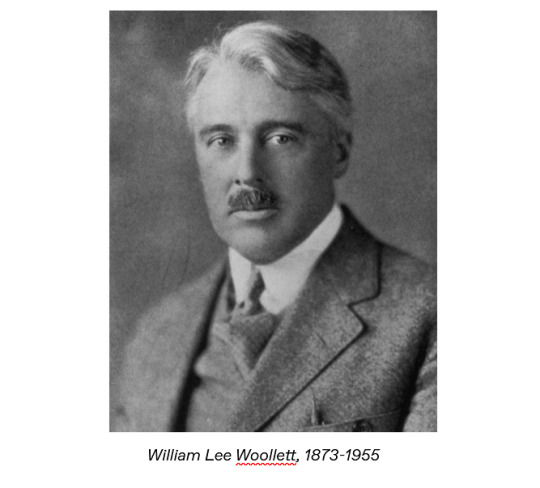
William Lee Woollett (1873-1955) was an American architect who practiced mainly in California. He designed theaters in Los Angeles in the 1920s, including the largest movie theater ever built in the city, Grauman's Metropolitan Theater, which opened in 1923. Woollett was born in Albany, New York, on November 13, 1873 to William M. and Sarah Louise Woollett. Woollett senior was also an architect.
Around 1892, Woollett studied architecture at the Massachusetts Institute of Technology. He apprenticed as a draftsman for Fehmer & Page, Architects, Boston, MA (1892-1896).
Woollett returned to Albany in 1896 to open his office. He was joined a few years later by his younger brother, John Woodward Woollett, also an architect. Together, they founded the firm, Woollett and Woollett Architects becoming the 3rd consecutive generation of Woolletts to practice architecture in Albany. After the San Francisco earthquake of 1906, Woollett and Woollett opened a branch office in San Francisco. William Woollett moved his family to Berkeley in 1908 and closed the Albany office. Woollett and Woollett was located in San Francisco until 1917 when William Lee Woollett relocated to Los Angeles. In 1921, the firm relocated permanently to Los Angeles. [Source: https://en.wikipedia.org/wiki/William_Lee_Woollett]
There is little biographical information on Woollett; to date, I haven't even been able to locate an obituary. The fact that he was part of a dynasty of Woollett architects (grandfather William Lee, father William M., William Lee and his brother John W., a son William Lee, and a grandson Joseph L.) is interesting in itself; William Jr. or II, FAIA (1901-1988) provides a brief account of his own professional beginnings in his book California's Golden Age. [https://archive.org/details/californiasgolde00wool/page/n1/mode/2up; limited preview]
Woollett published articles (including Concrete in Creative Architecture, Scene Painting in Architecture, both linked below), illustrations, and competition designs in various journals.
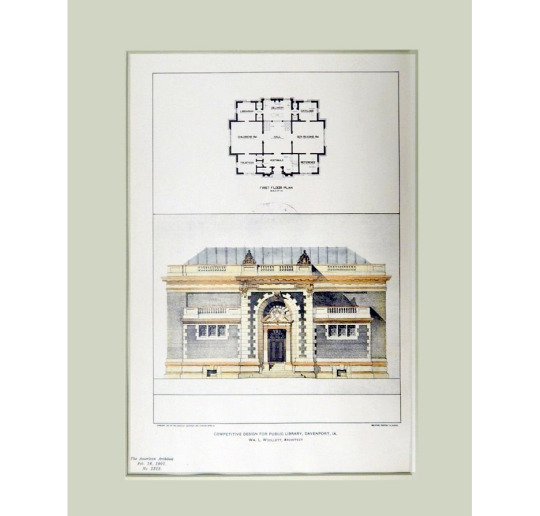
William Lee Woollett, Competitive Design for Public Library in Davenport Iowa. The American Architect Feb. 1901
An outline of Woollett's working life is given in his PCAD entry:
From Pacific Coast Architecture Database (PCAD) entry William Lee Woollett (Architect):
Résumé Draftsman, Fehmer and Page, Architects, Boston, MA, c. 1892-1896. Partner, William Lee Woollett and John W. Woollett, Albany, NY, -1906. This firm operated solely in the Albany, NY, area until 1906. A note in the Real Estate Record and Builders' Guide of 04/18/1903 stated: "William L. Woollett, architect, of Albany, has completed plans for alterations to St. Peter's Hospital, Albany, to cost $10,000, and for an addition 65x45, to cost $50,000. The latter will be fireproof and contain all appliances that go to equip a modern hospital. No expense will be spared to furnish the best plumbing,, heating and ventilating apparatus. The contract for the carpentry has been let to Patrick McCann, and the masonry to Collins Bros."... Partner, Woollett and [J.W] Woollett, Architects, San Francisco, CA, and Albany, NY, 1907-1917. It appears that Woollett chose to leave Albany to start a new branch of the Woollett and Woollett architectural firm in San Francisco following the Great Earthquake and Fire of 04/18/1906.Woollett and Woollett had its office in the Monadnock Building in 1907-1908.... In 1915, the Woollett and Woollett office was located at 260 California Street in San Francisco.... On his World War I draft registration form, Woollett indicated that he lived in Los Angeles, but worked in Sacramento, CA. In 1921, his office was located at 405 South Hill Street, Room #216. (See Los Angeles, California, City Directory, 1921, p. 2688.) He moved to new quarters at523 West 6th Street, Room #1121, by 1924. (See Los Angeles, California, City Directory, 1924, p. 2393.) Professional Activities Woollett served on the Los Angeles Municipal Art Commission until 1936.
Some of Woollett's significant buildings are illustrated below. Perhaps a scholar with access to the Woollett papers at UC Santa Barbara will someday compile a catalogue raisonné of his work, along with a more complete biography.
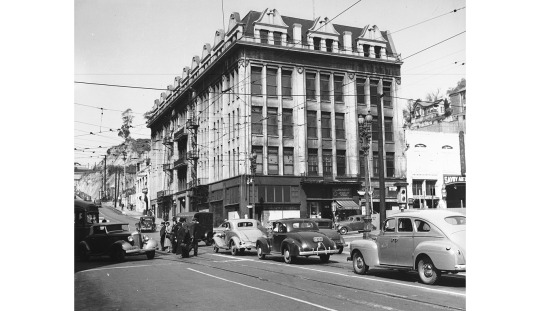
Tajo Building, Los Angeles, 1897, George Herbert Wyman and William Lee Woollett, architects

San Francisco Armory, 1914, Woollett and Woollett, architects
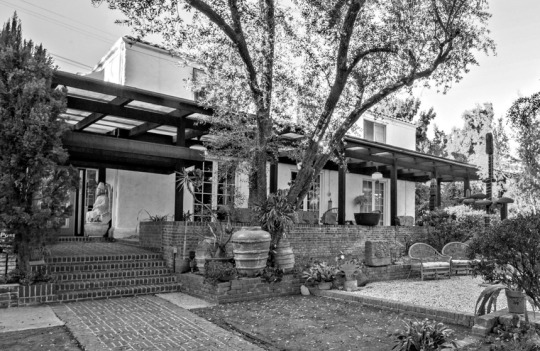
Arensberg House, Los Angeles, 1921
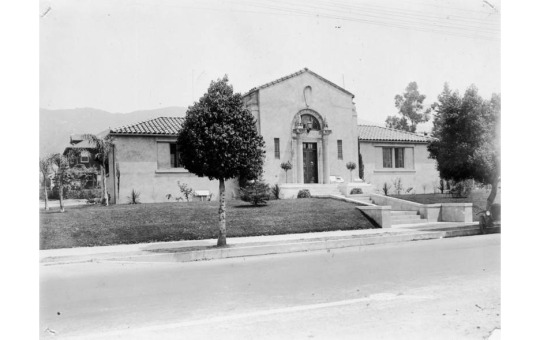
Eagle Rock City Hall, 1923. Security Pacific Photograph Collection, Los Angeles Public Library
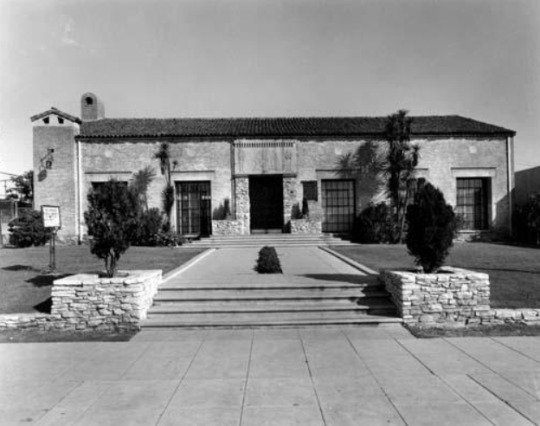
Los Angeles Public Library, Malabar Branch, 1927

Proposed design for a Los Angeles Civic Center, 1936
Woollett was responsible for the designs of three movie theaters in Los Angeles: The Rialto (Quinn’s Rialto opened 1917, designed by A.R. Walker; remodeled by Woollett after Sid Grauman’s purchase in 1919); the Million Dollar Theater of 1918 (Albert C. Martin, architect of the office building and exterior; theater interior designed by Woollett); and Grauman’s Metropolitan of 1923 (Edwin Bergstrom, building architect, theater interior designed by Woollett; renamed the Paramount in 1929).
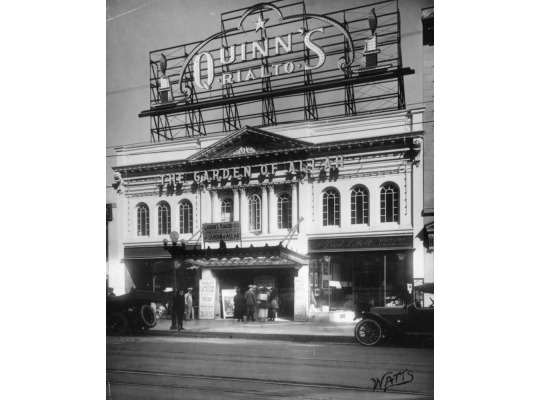
Quinn's Rialto, 1917, exterior. Security Pacific Photograph Collection, Los Angeles Public Library
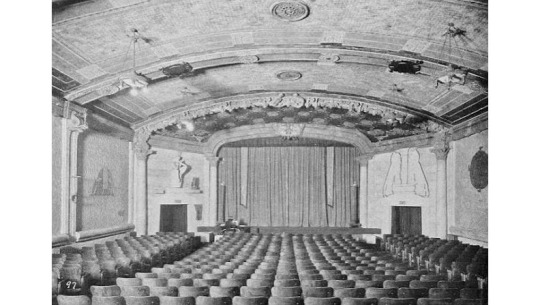
Rialto Theater, as remodeled by Woollett, 1919
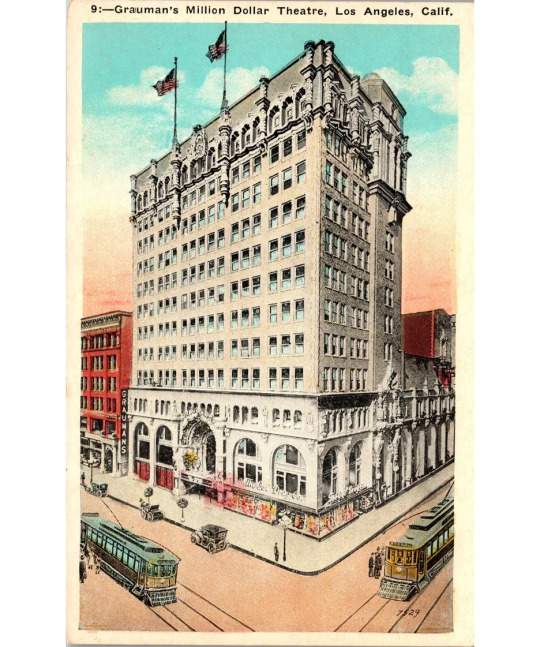
Grauman's Million Dollar Theatre and office building, Los Angeles, 1918
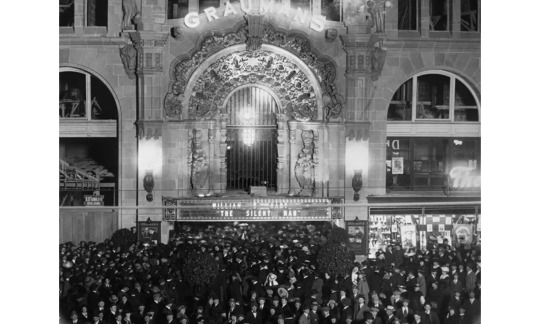
Grauman's Million Dollar Theatre, opening night, February 1, 1918
Grauman's Metropolitan Theater, Los Angeles
Grauman's Metropolitan opened with great fanfare on Friday January 26, 1923, showing "My American Wife" starring Gloria Swanson and Antonio Moreno. Gloria and several other stars of the picture attended, with the stage portion of the program headlined by Fred Waring and the Pennsylvanians.
The L.A. Times had quoted Grauman as saying "The Metropolitan Theater is to be the very center of the motion-picture universe," noting that the rest of the opening night program would include "The Star Spangled Banner" with the orchestra plus Henry Murtagh at the organ. There would be a chorus of 500 and an unfurling of what was said to be the largest flag in the world. Following this patriotic display would be the overture and "Pilgrim’s Chorus" from "Tannhauser" then "Ave Maria" with forty violinists and "eight expert harpists." “Dancing acts in which a ballet of 200 artists will be employed." [Source: Los Angeles Times, January 21, 1923, cited in Metropolitan / Paramount Theatre: History at https://losangelestheatres.blogspot.com/2018/10/metropolitan-theatre.html]
Views of the theater and its interior have been extensively reproduced on the website misterdangerous as well as Los Angeles Theatres; links to the PDF versions of some of the publications cited are included in the Links section below. Some representative illustrations are shown here.
The office building's architect was George Edwin Bergstrom, and the theater interior was designed by Woollett. Bergstrom probably gained significant amounts of expertise in reinforced concrete construction in his work on industrial buildings; these skills would have been profitably used in the Metropolitan building.
With 3,600 seats, the Metropolitan was the largest movie house ever built in Los Angeles. Its construction was a marvel; its poured concrete had to be supported by huge wooden armature (about 400,000 board feet of lumber went into the "falsework" alone). Ten roof trusses spanned 126 feet, the largest truss supported the four balcony cantilevers, absorbing 100 tons of reinforcing steel and 570 cubic yards of concrete, poured in a continuous run of 47 hours. [Source: Theatre Historical Society Annual No. 23, 1996]
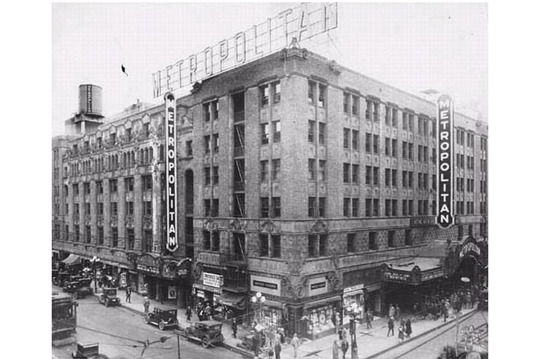
Graumans's Metropolitan, S. Hill and 6th Streets, Los Angeles. Address: 323 W. 6th St., 536 S. Hill St. and 553 S. Broadway Los Angeles, CA 90014
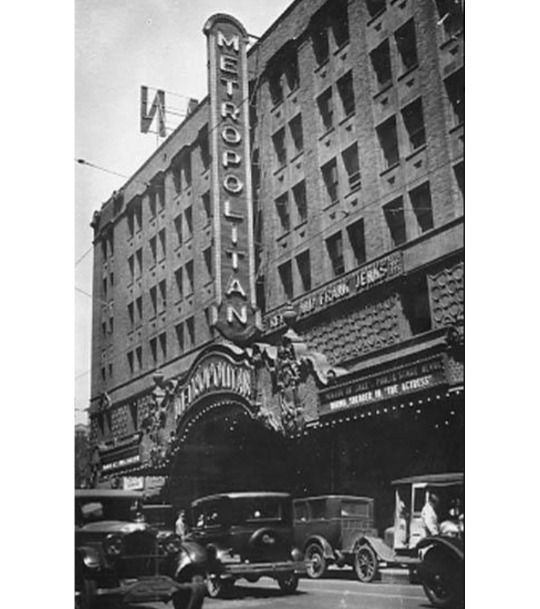
Grauman's Metropolitan theater marquee
Originally intended to rise 13 stories (then the building height limit in Los Angeles), the final height was six stories.
The main theater entrance was on 6th Street, with a side entrance on Hill Street, facing Pershing Square. A short-lived third entrance on Broadway featured both a mammoth cast-concrete sculpture and an escalator leading to a bridge connecting to the theater building. This entrance was closed in 1926.
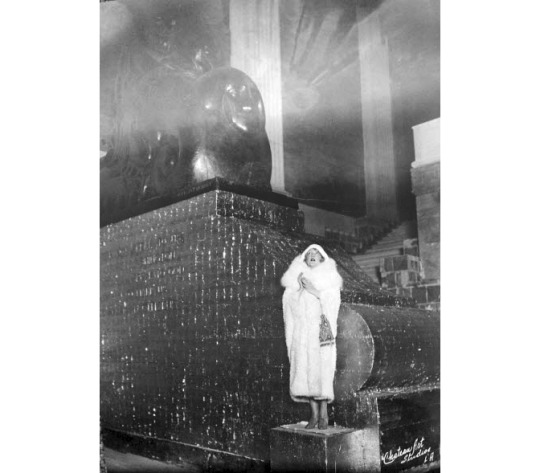
Screen actress Mae Murray admires the lobby of the Broadway entrance to the Metropolitan
After nearly 30 months of construction, upon the Metropolitan's opening the theater's design was greeted with both confusion and admiration. Idiosyncratic details such as the bizarre sculptures of a "snail deer" and a clawed figure of a garden slug with human face titled "Procrastination" must have both amused and repelled the public.
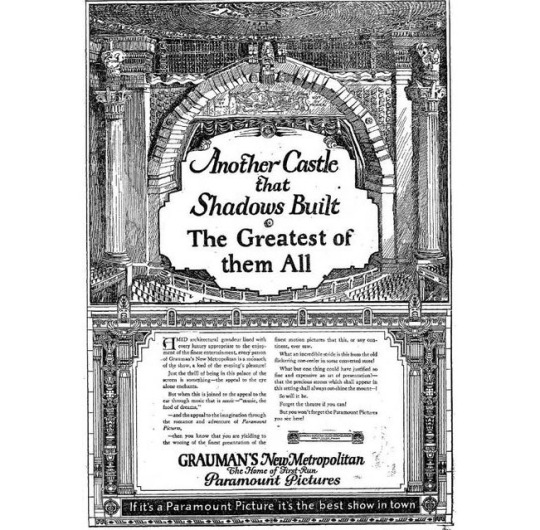
Opening night advertisement
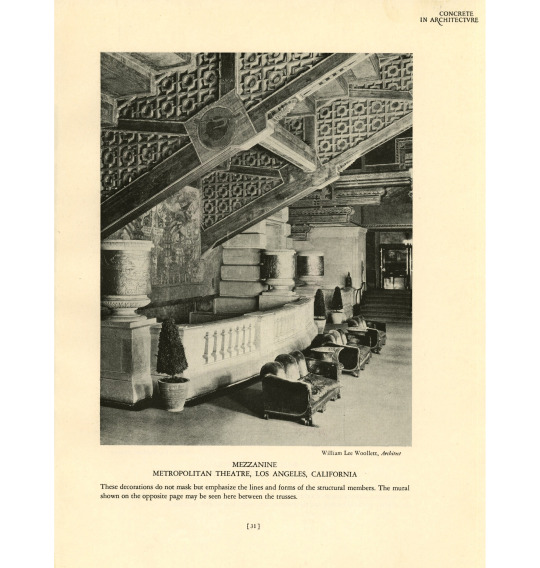
Theater mezzanine, from Concrete in Architecture
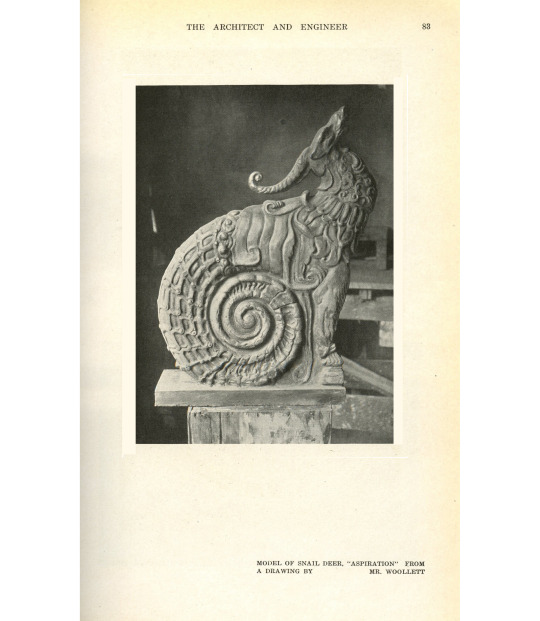
Model of snail deer, "Aspiration" from a drawing by Mr. Woollett, The Architect and Engineer
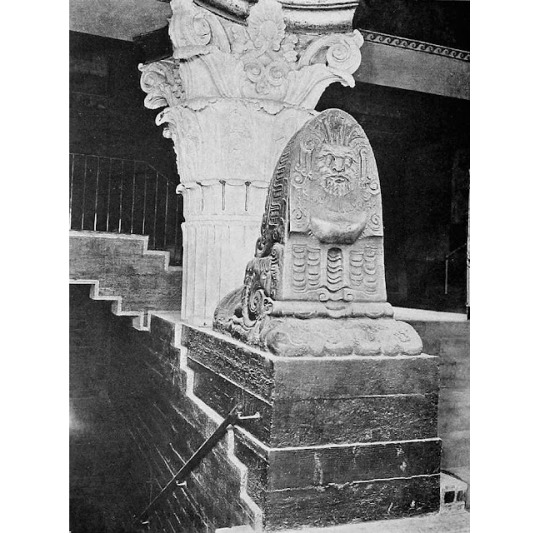
"Procrastination" sculpture
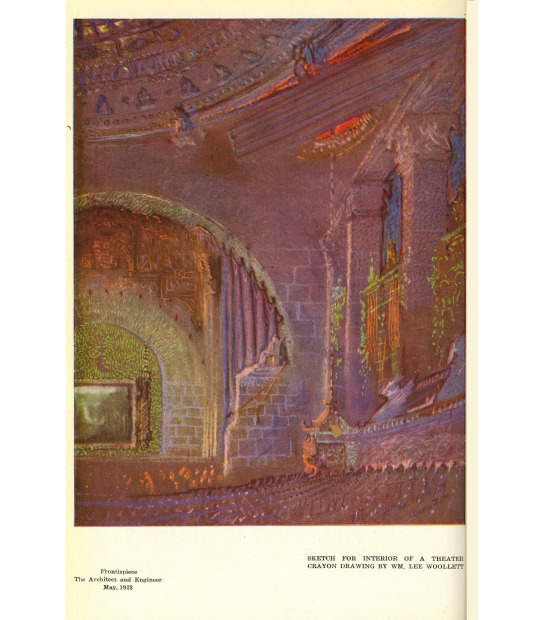
Sketch for interior of a theater, crayon drawing by Wm. Lee Woollett, The Architect and Engineer, May 1923
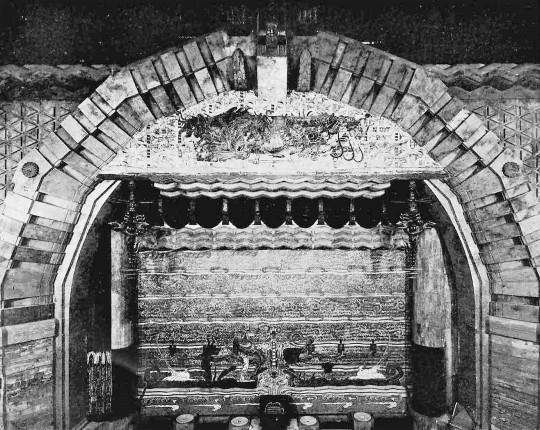
Proscenium, Metropolitan Theater, with the Metropolitan's asbestos curtain. The organ console is in its upper position, above stage level. The mural in the top of the arch was titled "Not By Might, Not By Power." The painted fire curtain, according to Woollett, depicted a satire on Wells' History of the World. From the September 1923 issue of The Building Review.
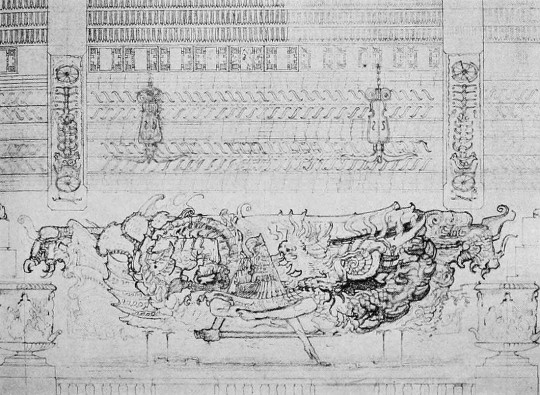
Sketch for the mural "Not by Might, Not by Power" in the upper proscenium.
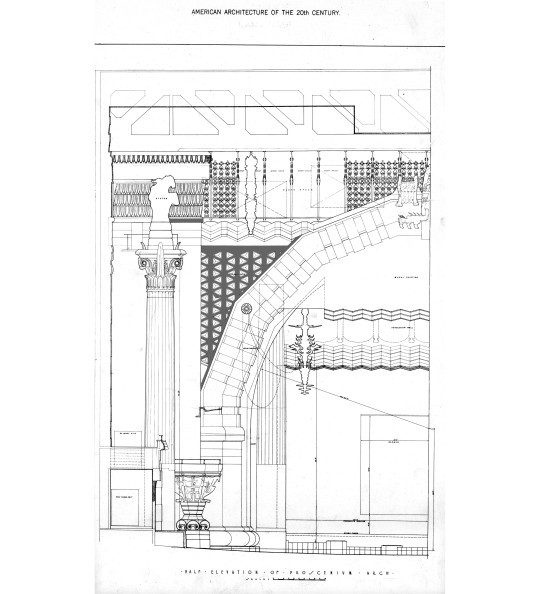
Half elevation of proscenium arch, from American Architecture of the 20th Century
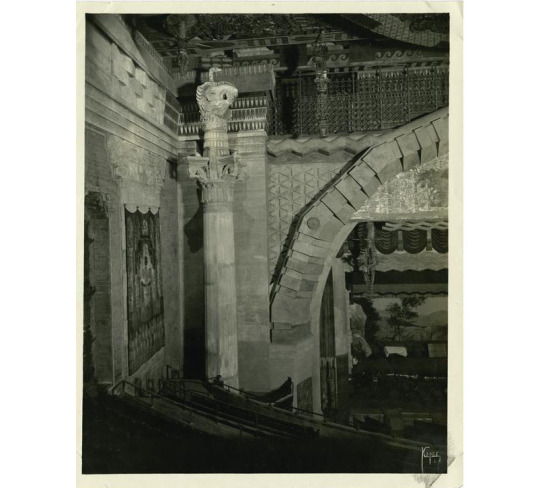
Auditorium interior with proscenium

Mural in the Metropolitan Theatre, William Lee Woollett at right. The mural, "Princess of the golden Kingdom," was painted by Paul K. Mays and Steffan Horbaczek. Security Pacific Photograph Collection, Los Angeles Public Library
Grauman was constructing the Egyptian Theater on Hollywood Blvd. at the same time as the Metropolitan; the Egyptian opened in 1922 just months before the Metropolitan, to be followed in 1927 by Grauman's Chinese. Grauman's name in lights above the Metropolitan's marquee remained for only three years; he passed stewardship of the theater to Paramount Pictures, which redubbed it the Paramount in 1929. Grauman had banked on the shifting entertainment district from Broadway in downtown L.A. to Hollywood.

The wall hanging on the house right stairs. "Mr. God" panel in Panne velvet designed by the architect, executed by E.J. MacKeever. Such bizarre details as "the sarcophagus of the unknown dead" must have both amused and perplexed moviegoers. Photo: Architect and Engineer - May 1923
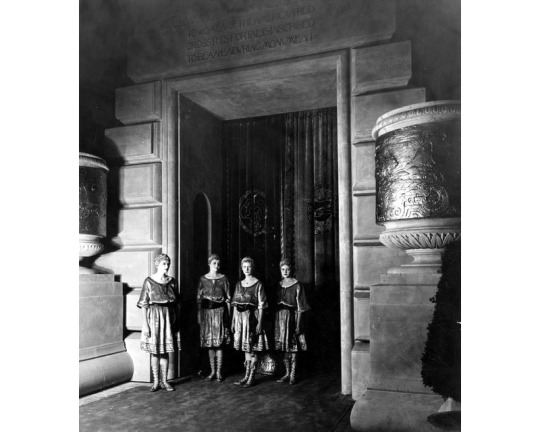
Ushers, Metropolitan Theater
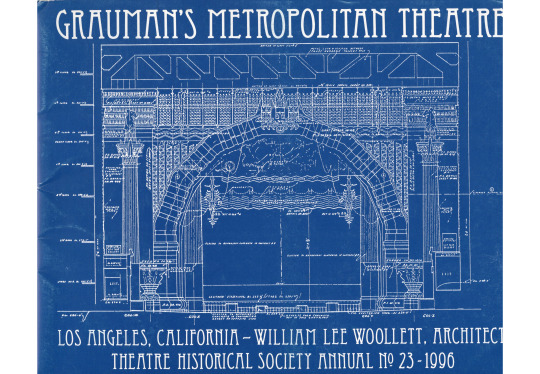
The Theatre Historical Society Annual No. 23, 1996, was devoted to the Metropolitan Theatre, and included selections from from The Architect & Engineer, May 2023.
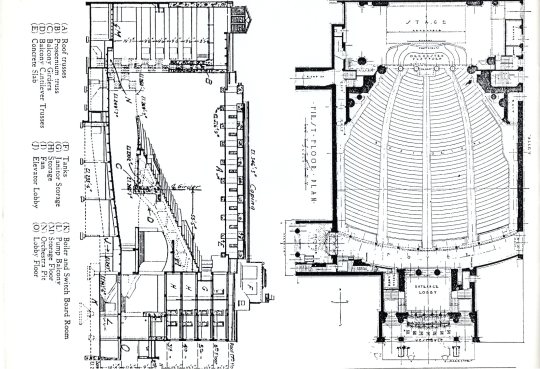
Section and main floor plan, as reproduced in the Theatre Historical Society Annual, 1996
The theater building was demolished in 1961-62; due to its solid concrete construction, the first demolition contractor went bankrupt, before a second, more knowledgeable, contractor finished the job. The 16-story, 410,000 square feet, $51 million International Jewelry Trade Center, in faceted white granite, opened on the site in 1981, designed by Skidmore, Owings & Merrill.

Demolition, 1960s
William Lee Woollett's papers were given to the Architecture and Design Collection of the Art, Design and Architecture Museum, University of California, Santa Barbara (UCSB), in 1981 by his son, William Lee Woollett, FAIA (1901-1988).
Links to PDF Documents:
Concrete and Creative Architecture, The Architect & Engineer, May 1923
Grauman Theater a Work of Art, The Architect & Engineer, May 1923
The Million Dollar Theatre - Los Angeles, California
A New Play House - The International Studio Nov. 1919
Woollett, Scene Painting in Architecture - The Architectural Record Nov 1915
Reflections on the Grauman Metropolitan Theater, Los Angeles, by Bernard Maybeck, the Architect and Engineer
Notable Stage Elevator Installation in the Metropolitan, The Architect and Engineer
Websites:
Metropolitan Theater – Los Angeles - misterdangerous
Finding Aid for the William Lee Woollett papers, circa 1920-circa 1980 0000198
William Lee Woollett Buildings & Publications
A New Administration Center for Los Angeles
Inside the Legendary Art-Filled Home of Walter and Louise Arensberg
Metropolitan / Paramount Theater Los Angeles - images
Los Angeles Theatres; Metropolitan / Paramount Theatre: History
Woolletts in the USA
"Pioneers" and "Editorial," Grauman's Metropolitan Theater, The Building Review, 1923
#architecture#Woollett#William Lee Woollett#Metropolitan Theatre#Grauman#concrete#movie theater#movie palace#Grauman's Metropolitan#Los Angeles
0 notes
Text
Get Active and Explore Nature at Bayfront Park
Contra Costa County is home to a plethora of parks and nature reserves that offer visitors the opportunity to get outside, explore nature, and enjoy some fresh air. One such park that is definitely worth a visit is Bayfront Park, located in the city of Pinole.
Bayfront Park is a sprawling green space that spans over 42 acres and is situated on the banks of the San Pablo Bay. It is a popular destination for hikers, bikers, joggers, and anyone who loves to spend time in the great outdoors.
The park features a network of trails that wind through a variety of landscapes, including wetlands, grasslands, and forests. Whether you're looking for a leisurely stroll or a challenging hike, Bayfront Park has something for everyone.
One of the most popular trails in the park is the Bay Trail, which offers stunning views of the San Pablo Bay and the surrounding hills. This trail is accessible to hikers, bikers, and even horseback riders, and is a great way to explore the park's diverse terrain.
In addition to its trails, Bayfront Park also features a range of amenities that make it a great destination for families and groups. The park has picnic areas with tables and grills, making it the perfect spot for a family outing or a group barbecue.
For those who want to get out on the water, Bayfront Park also has a boat launch that allows visitors to launch kayaks, canoes, and other small watercraft. The park's location on the San Pablo Bay makes it an ideal spot for paddling and exploring the bay's many inlets and coves.
And if you're looking for a bit of history, Bayfront Park has got you covered. The park is home to the Pinole Shores Historical Society, which has restored the historic Pinole Wharf and Warehouse. The wharf was once a bustling center of commerce and transportation, and now serves as a fascinating window into the region's past.
Additionally, Bayfront Park offers a variety of activities and events throughout the year, such as outdoor concerts and movie screenings. The park is also home to many species of birds, mammals, reptiles, amphibians, fish, and other wildlife. Visitors can take part in guided bird watching tours or explore the park's nature trails on their own to discover native plants and animals.
Whether you're looking to relax, explore nature, or get active, Bayfront Park has something for everyone. With its stunning views and diverse range of activities, it's no wonder that this park is a favorite among locals and visitors alike.
Overall, Bayfront Park is a must-visit destination for anyone looking to get active and explore nature in Contra Costa County. With its extensive network of trails, picnic areas, and water access, there is no shortage of ways to enjoy this beautiful park.
Summing up, Bayfront Park has activities for everyone including hiking, biking, kayaking, and picnicking. You can enjoy beautiful views while relaxing or exploring this park. Visit Bayfront Park to experience the natural beauty of Contra Costa County.
#room addition contractors near me#room addition cost in berkeley#ca#adu in berkeley#room addition#garage conversion living space#Contra Costa County#berkeley
0 notes
Text
The “sophisticated honey of 1960’s counterculture jargon” by Mose Durst

▲ Two of a series of booklets by Mose Durst full of the “sophisticated honey of 1960’s counterculture jargon.” The back cover of each is below.

_____________________________________ MOONWEBS – Journey into the Mind of a Cult A gripping personal account (1980) by Josh Freed (Award Winning Canadian Journalist)
Here are a few edited extracts:
“…when Moon arrived in 1971, he furiously reorganized the U.S. Church, changing its structures and beginning a major recruiting drive. According to Gary Scharff, a top Moon instructor at the time, Moon single-handedly brought in the rigid indoctrination techniques that were first practised at the New York Barrytown center under the title of “100-day Training Program”.
“Moon gave us the specifics as soon as he arrived from Korea,” recalls Scharff. “The hours a day, the precision of activities, the discipline—we had to be up at 6 a.m. and in formation at 6:08 like the cadets. Moon developed the 100-day training program entirely on his own…he’s a very effective human manipulator.”
Moon’s heavy-handed methods were immediately effective at turning veteran Church members into disciplined zealots, but did not attract youth of the sixties generation. The Church required one more addition before it could begin its ascendancy in America: the arrival of Dr. Mose (Martin) Durst, a fuzzy-haired west coast teacher who coated Moon’s mind-bending indoctrination techniques with the sophisticated honey of 1960’s counterculture jargon.
Durst is an English professor at Laney College and joined the Church’s hierarchy after marrying Moon missionary [Onni Yeon-Soo Lim] in December 1974. West Eden is their $325,000 home in Berkeley.

Ex-Moonies who have visited the couple’s residence describe a magnificent manor with a park, an enclosed pool and a sauna. Four Church members act as servants, closets are stuffed with furs and silk dressing gowns, and a solid-gold replica of a Korean crown is said to adorn the living room.
As head of the Creative Community Project, Durst soon helped introduce many of the features of today’s Boonville program: the deception, misrepresentation and progressive indoctrination that lures recruits into the Church step by step.
“With no labor costs and people willing to work 15 hours a day, you can undercut anyone,” says Jeff Scales, former manager of Aladdin’s restaurant. Scales says he once took about $20,000 from staff’s salaries to buy a metallic blue Mercedes as a gift for Mose and Onni Durst.”
_____________________
Boonville was purchased in 1970 by Sang-Ik Choi, known as Papasan Choi. He and his wife, known as Mamasan, led the International Re-Education Center [in San Francisco] which he had founded. Mamasan’s role in the community was significant.
Papasan Choi’s secular teachings, The Principles of Education, were the foundation for the teaching methods used in Oakland and Boonville by Onni Durst, Mose Durst, Kristina Morrison Seher and the Creative Community Project team.
Ref: A History Of The Unification Church In America, 1959-74 – Emergence of a National Movement (1993) by Michael L Mickler
_____________________
Rev. Sun Myung Moon (1978) by Chong-Sun Kim. University Press of America
“Furthermore, the International Re-Education Foundation had owned some land in Boonville, California, sometimes known as [New] Ideal City Ranch, which it turned over in a simple transfer of title in 1974 to the Unification Church.” (page 111)
_____________________
In this way Onni Durst inherited the Boonville property at around the time she was married to Mose Durst by Sun Myung Moon and made the leader of California (except Los Angeles) in December 1974.
_____________________
“Onni Durst is a woman of guts. While she was at a slot machine in Las Vegas, she completely ran out of coins; she went to the next person, smiled, and borrowed some coins.”
Sun Myung Moon (May 19, 1980, New York City)
_____________________
Moonwebs by Josh Freed
Papasan Choi and Boonville’s Japanese origins
Barbara Underwood and the Oakland Moonies
Life Among the Moonies by Deanna Durham
Ford Greene – the former Moonie became an attorney
Inside Look at a Boonville Moonie Training Session
Mitchell was lucky – he got away from the Unification Church
My Time with the Oakland Family Moonies – by Peter from New Zealand
Crazy for God: The nightmare of cult life by Christopher Edwards
The Social Organization of Recruitment in the Unification Church PDF
by David Frank Taylor, M.A., July 1978, Sociology
“Socialization techniques through which the UC members were able to influence” by Geri-Ann Galanti, Ph.D.
The FFWPU / Unification Church and Shamanism
Sun Myung Moon’s theology used to control members
“Project Volunteer” – Moonies Infiltrate Aid-To-The-Elderly Groups, (Berkeley Barb, Oakland 1978)
Mose and Onni Durst – their legacy
Onni Durst’s trips to Las Vegas casinos, New York, and Seoul – and her luxurious lifestyle.
1 note
·
View note
Text
Turbocharge your audition skills with the San Francisco Academy Orchestra
videos, photos, and more available here
For classical musicians, learning how to audition effectively is critical. So much is riding on the line when you take an audition.
You��ve spent months preparing the music.
You’ve booked a flight and hotel, turned down gigs. You’ve invested an incredible amount of time and emotional energy into this event.
Then what happens? For so many musicians, they get nervous, flub a couple of notes, and then watch in panic as everything spirals downhill. Finding ways to simulate the audition experience is key to developing these skills.
In my 2016 book Winning the Audition, I took advice from over two dozen professional orchestra musicians and wove it into a book that covered practice techniques, mindset, overcoming adversity, and other key skills.
More recently, I had the pleasure of being a “fly on the wall” for one of the San Francisco Academy Orchestra’s monthly mock auditions. This is a super-cool part of an innovative new program, and it is a great new way for people on the verge of a career to get that “final finish” to make it into a professional orchestra job.
About the San Francisco Academy Orchestra Program
This string-focused orchestral training program puts emerging professionals alongside San Francisco Symphony members, rehearsing and performing side-by-side throughout the year. This program was launched by Andrei Gorbatenko in 2000 and features faculty members from the San Francisco Symphony and Opera as well as various guest artists.
More recently, the Academy also launched an intensive, one-year Artist Diploma Fellowship that focuses on developing those skills critical to orchestral performance. The program offers weekly lessons, group excerpt classes, master classes, and mock auditions in addition to the side-by-side rehearsal and performing with San Francisco Symphony members.
A Look Inside the Mock Audition Process
I arrived a half-hour early for the Academy’s December 2019 mock audition and sat down with mock audition coordinator Joy Fellows. Joy is a violist in the San Francisco Opera as well as the San Francisco Ballet Orchestra. She also teaches viola through the Academy. Prior to that, Joy was a member of the Saint Louis Symphony and the Indianapolis Symphony.
Why Mock Auditions Help
Joy and I chatted about auditions in general and developing the process of centering, a concept popularized in the orchestral world by performance coach Don Greene. Deliberate practice toward centering to center yourself in the moment to accomplish the task at hand is key.
Dealing with the stress of an audition experience is a challenge for sure. Everyone has slightly different mechanisms for coping with these moments. Unfortunately, there isn’t one “magic bullet” that will universally address the panicky feeling surrounding an audition.
For more people, it’s eating a banana before the audition. Others moderate their caffeine intake, and some incorporate beta blocker medication.
Everybody is slightly different, and playing mock auditions is a great way to “practice the audition” and learn how to cope with these audition-specific challenges.
Common Audition Preparation Mistakes
Not having truly practiced the entire audition list is one of the most common preparation missteps that Joy has observed. Getting every excerpt to the same level is critical for an audition. Often, a player may focus so much on one of the more unfamiliar or challenging excerpts that they neglect the rest of the list.
Time management, planning, and being really organized and specific about your preparation will help tremendously with moving all of the excerpts to where they need to be in terms of preparation.
Recording yourself is an essential tool for audition preparation. For Joy, she would start recording herself every few days about three weeks prior to the audition. She would then listen back and take a lot of notes on how things were going and what work needed to be done next.
Taking notes like this is great because it reveals what really needs work. Focusing on just those spots identified in the last recording ensures that the focus is being directed toward what actually needs to get done.
This kind of preparation is great for calming the nerves. Because you’ve put so much thought and effort into what you’re doing, you’re less likely to be distracted in the audition itself.
Ideally, Joy wants to be performing the whole list for a variety of different people about a week before the audition. Family, friends, and colleagues are all great candidates for this. The experience of playing an audition list in front of another human is incredibly powerful, and most audition winners credit this as on off the keys to their audition success.
The goal is to get your worst possible performance and your best possible performance as close to each other as possible. Los Angeles Philharmonic bassist David Allen Moore refers to this as “your floor and your ceiling.” In audition preparation, we aim to raise our floor as close as possible to the level of our ceiling.
The Structure of the San Francisco Academy Orchestra Auditions
Mock auditions for the San Francisco Academy Orchestra are held at the Drew School in San Francisco. This private school in San Francisco‘s Pacific Heights neighborhood has a great auditorium and numerous warm-up rooms located below it.
The screen is set up across the stage, with mock audition “candidates” entering from a separate door on the left. The mock auditioners are divided into two rounds of A and B groups, and one group warms up as the other listens and writes comments.
I floated behind both sides of the screen, checking out the experience from both the committee and player perspective. It was great to see how different people warmed up and conducted themselves during the mock audition.
Several people were playing off of an iPad Pro, which I’ve also embraced as my music reading device. Others had a stack of parts and were jotting down notes and rearranging the music for their mock round.
Each candidate played a series of 4-5 short excerpts from the standard audition repertoire. Though nerves play a role in pretty much every actual or mock audition, all the candidates seemed quite composed. This is a good indication of the positive effect that doing regular mock auditions has on these artist diploma students.
There’s also tremendous benefit in listening to and receiving comments from musicians that don’t play your instrument. Violinists listen differently than bassists, for example—and vice versa.
Everybody behind the screen, including both mock auditioners and faculty members like Joy and Andrei, took notes. Everybody put their notes into piles for each candidate at the conclusion of each round.
The whole process was professional, seamless, and well-executed. I wish I had been put through a similar process back when I was studying!
Academy Members are Winning Auditions
After the mock audition, we all headed over to Andrei’s place for their annual holiday party. It was a ton of fun and great way for faculty and fellows to relax and spend time together.
I chatted with Andrei about the origins of the academy and the more recent development of its artist diploma program.
For nearly twenty years, the Academy program has given young professional musicians to work alongside members of the San Francisco Symphony.
Six years ago, former San Francisco Symphony Assistant Principal Viola Don Ehrlich and Andrei came up with the idea for the Artist Diploma program. This program serves as a response to the ever-increasing music tuition costs, this program is designed to be efficient and focus on the essential skills for obtaining employment in an orchestra.
The program consists of: weekly lessons group excerpt classes master classes mock auditions side-by-side rehearsal and performing with San Francisco Symphony members
The results have been remarkable.
Academy Fellows have recently won auditions or have been awarded contracts with the following orchestras:
Pittsburgh Symphony Dallas Symphony Rochester Philharmonic St. Louis Symphony Calgary Philharmonic Annapolis Symphony Philharmonia Baroque Austin Symphony Santa Barbara Symphony California Symphony Santa Cruz Symphony Berkeley Symphony Monterey Symphony Oakland Symphony Marin Symphony Santa Rosa Symphony Symphony Silicon Valley Stockton Symphony Sacramento Philharmonic San Jose Chamber Orchestra
Many of them have also been called to sub in the San Francisco Symphony, San Francisco Opera and San Francisco Ballet Orchestras.
Faculty
In addition to Andrei, the Academy the faculty consists of:
Dan Carlson, violin David Chernyavsky, violin Melissa Kleinbart, violin Matthew Young, viola Joy Fellows, viola Amos Yang, cello Charles Chandler, bass
Auditioning From the Violinist Perspective
I also spoke with San Francisco Symphony violinist and Academy teacher David Chernyavsky about the program while at the holiday party. David moved to the Bay Area in 2009 and has been involved with the Academy for the last decade.
David works on a weekly basis with the Academy fellows in the Artist Diploma Program, concentrating on the audition repertoire needed to prepare them for real-life auditions.
David has observed that, surprisingly, many string players leaving school have not focused enough on orchestral repertoire and training for taking auditions.
During the past few decades in the United States, the requirements to get a job have shifted more toward successful execution of orchestral excerpts. Before that, there was more of an emphasis on solo repertoire. For example, auditions in the 1960s might have consisted of a concerto movement and some orchestral sightreading. This is quite a different setup compared to today’s audition process.
There are multiple levels on which people are listening to excerpts. Take the first page of the violin part of Don Juan, for example. The challenge is that this is an orchestral part, so you have to keep in mind that you have to play it as if you were in the first violin section. This means that you cannot play too virtuosically. You have to play more rhythmically.
On the other hand, you have to sound good playing an orchestral part alone. In as section, you are playing with up to 20 other people, while in an audition you are playing this tutti part as a solo instrument.
The main objective is to not rush and have a strong sense of rhythm and tempo.
Executing a Mozart concerto is a different skill set. David likes to tell his students to imagine singing it, or to imagine a soprano singer singing this music. A lot of people try to play Mozart concerti with short articulations, making a lot of accents and with a dry approach.
David finds Mozart concerti to be much more appealing with a song like approach to the line and phrasing. This can be a bit counterintuitive due to all the articulations in the part, but in the end it sounds more flowing and cohesive with a songlike approach.
Charles Chandler on the Academy experience
San Francisco Symphony bassist Charles Chandler and I chatted about the San Francisco Academy experience in our 2017 interview. Here’s Charles on his experience working with the Academy students:
“It’s mostly graduate students, and it’s a program that costs a lot less than going to a conservatory. You have an experience of playing in orchestra, but most importantly take lessons, and actually all of the teachers are members of the San Francisco Symphony there.
You get to work with them on a one-on-one basis, and in a orchestra class setting as well. it’s great—it’s really great. I really enjoy it. The students have all been fantastic players and students, and I feel like I’ve learned a whole lot from them, frankly!”
Thoughts from the students
Finally, I chatted with current San Francisco Academy Orchestra students Michael Minor and Yu Chen Liu.
Prior to her time with the Academy Orchestra, Yu Chen Liu attended the San Francisco Conservatory, where she studied with Scott Pingel for her master’s degree. Yu Chen loves the city of San Francisco: the people, the lifestyle, and the weather. She has gotten a lot of the monthly mock auditions (this was her 12th for the program), the studio classes, and the orchestral experience.
Mock auditions are one of Yu Chen’s favorite aspects of the program. She records herself every time, and she can hear the improvement from audition to audition each time she listens to the recording. Each time, she can hear herself getting better, not only technically, but also in how she reacts to the pressures of the mock audition experience.
Michael Minor is another former San Francisco Conservatory student, and he’s enjoying the training he’s getting with Charles and the warm, open approach he takes to music making. Getting to play with the Academy Orchestra is an inspiring experience, and having Andrei, a fellow bass player, as a conductor has been a rewarding experience.
Mock auditions are also a favorite part of the program for Michael. Playing in front of peers can be a scary experience, and these regularly scheduled mock auditions go a long way toward normalizing this process.
Learn more about the Academy
Andrei spends much of the academic year touring the United States, listening to auditions for the Academy, working with university ensembles and speaking with students.
Visit the San Francisco Academy website for more information, and follow along with them on Facebook for the latest updates.
Check out this episode!
1 note
·
View note
Text
Organic farming with gene editing: An oxymoron or a tool for sustainable agriculture?
by Rebecca Mackelprang

Many farmers cultivating organic crops believe that genetically modified crops pose threats to human health. mythja/Shutterstock.com
A University of California, Berkeley professor stands at the front of the room, delivering her invited talk about the potential of genetic engineering. Her audience, full of organic farming advocates, listens uneasily. She notices a man get up from his seat and move toward the front of the room. Confused, the speaker pauses mid-sentence as she watches him bend over, reach for the power cord, and unplug the projector. The room darkens and silence falls. So much for listening to the ideas of others.
Many organic advocates claim that genetically engineered crops are harmful to human health, the environment, and the farmers who work with them. Biotechnology advocates fire back that genetically engineered crops are safe, reduce insecticide use, and allow farmers in developing countries to produce enough food to feed themselves and their families.
Now, sides are being chosen about whether the new gene editing technology, CRISPR, is really just “GMO 2.0” or a helpful new tool to speed up the plant breeding process. In July, the European Union’s Court of Justice ruled that crops made with CRISPR will be classified as genetically engineered. In the United States, meanwhile, the regulatory system is drawing distinctions between genetic engineering and specific uses of genome editing.

For many, perception of genetically modified foods has changed little from those of this protester dressed as a genetically altered ‘Killer Tomato’ marching through downtown San Diego, June 24, 2001. Joe Cavaretta/AP Photo
I am a plant molecular biologist and appreciate the awesome potential of both CRISPR and genetic engineering technologies. But I don’t believe that pits me against the goals of organic agriculture. In fact, biotechnology can help meet these goals. And while rehashing the arguments about genetic engineering seems counterproductive, genome editing may draw both sides to the table for a healthy conversation. To understand why, it’s worth digging into the differences between genome editing with CRISPR and genetic engineering.
What’s the difference between genetic engineering, CRISPR and mutation breeding?
Opponents argue that CRISPR is a sneaky way to trick the public into eating genetically engineered foods. It is tempting to toss CRISPR and genetic engineering into the same bucket. But even “genetic engineering” and “CRISPR” are too broad to convey what is happening on the genetic level, so let’s look closer.
In one type of genetic engineering, a gene from an unrelated organism can be introduced into a plant’s genome. For example, much of the eggplant grown in Bangladesh incorporates a gene from a common bacterium. This gene makes a protein called Bt that is harmful to insects. By putting that gene inside the eggplant’s DNA, the plant itself becomes lethal to eggplant-eating insects and decreases the need for insecticides. Bt is safe for humans. It’s like how chocolate makes dogs sick, but doesn’t affect us.
Another type of genetic engineering can move a gene from one variety of a plant species into another variety of that same species. For example, researchers identified a gene in wild apple trees that makes them resistant to fire blight.They moved that gene into the “Gala Galaxy” apple to make it resistant to disease. However, this new apple variety has not been commercialized.
Scientists are unable to direct where in the genome a gene is inserted with traditional genetic engineering, although they use DNA sequencing to identify the location after the fact.
In contrast, CRISPR is a tool of precision.
Just like using the “find” function in a word processor to quickly jump to a word or phrase, the CRISPR molecular machinery finds a specific spot in the genome. It cuts both strands of DNA at that location. Because cut DNA is problematic for the cell, it quickly deploys a repair team to mend the break. There are two pathways for repairing the DNA. In one, which I call “CRISPR for modification,” a new gene can be inserted to link the cut ends together, like pasting a new sentence into a word processor.
In “CRISPR for mutation,” the cell’s repair team tries to glue the cut DNA strands back together again. Scientists can direct this repair team to change a few DNA units, or base pairs (A’s, T’s, C’s and G’s), at the site that was cut, creating a small DNA change called a mutation. This technique can be used to tweak the gene’s behavior inside the plant. It can also be used to silence genes inside the plant that, for example, are detrimental to plant survival, like a gene that increases susceptibility to fungal infections.

In genetic engineering, a new gene is added to a random location in a plant’s genome. CRISPR for modification also allows a new gene to be added to a plant, but targets the new gene to a specific location. CRISPR for mutation does not add new DNA. Rather, it makes a small DNA change at a precise location. Mutation breeding uses chemicals or radiation (lightning bolts) to induce several small mutations in the genomes of seeds. Resulting plants are screened for beneficial mutations resulting in desirable traits. Rebecca Mackelprang, CC BY-SA
Mutation breeding, which in my opinion is also a type of biotechnology, is already used in organic food production. In mutation breeding, radiation or chemicals are used to randomly make mutations in the DNA of hundreds or thousands of seeds which are then grown in the field. Breeders scan fields for plants with a desired trait such as disease resistance or increased yield. Thousands of new crop varieties have been created and commercialized through this process, including everything from varieties of quinoa to varieties of grapefruit. Mutation breeding is considered a traditional breeding technique, and thus is not an “excluded method” for organic farming in the United States.
CRISPR for mutation is more similar to mutation breeding than it is to genetic engineering. It creates similar end products as mutation breeding, but removes the randomness. It does not introduce new DNA. It is a controlled and predictable technique for generating helpful new plant varieties capable of resisting disease or weathering adverse environmental conditions.
Opportunity lost – learning from genetic engineering
Most commercialized genetically engineered traits confer herbicide tolerance or insect resistance in corn, soybean or cotton. Yet many other engineered crops exist. While a few are grown in the field, most sit all but forgotten in dark corners of research labs because of the prohibitive expense of passing regulatory hurdles. If the regulatory climate and public perception allow it, crops with valuable traits like these could be produced by CRISPR and become common in our soils and on our tables.

Dr. Peggy Lemaux, holding seeds from the hypoallergenic wheat she helped develop with genetic engineering. James Block, CC BY-SA
For example, my adviser at UC Berkeley developed, with colleagues, a hypoallergenic variety of wheat. Seeds for this wheat are held captive in envelopes in the basement of our building, untouched for years. A tomato that uses a sweet pepper gene to defend against a bacterial disease, eliminating the need for copper-based pesticide application, has struggled to secure funding to move forward. Carrot, cassava, lettuce, potato and more have been engineered for increased nutritional value. These varieties demonstrate the creativity and expertise of researchers in bringing beneficial new traits to life. Why, then, can’t I buy bread made with hypoallergenic wheat at the grocery store?
Loosening the grip of Big Agriculture
Research and development of a new genetically engineered crop costs around US$100 million at large seed companies. Clearing the regulatory hurdles laid out by the U.S. Department of Agriculture, EPA and/or FDA (depending on the engineered trait) takes between five and seven years and an additional $35 million. Regulation is important and genetically engineered products should be carefully evaluated. But, the expense allows only large corporations with extensive capital to compete in this arena. The price shuts small companies, academic researchers and NGOs out of the equation. To recoup their $135 million investment in crop commercialization, companies develop products to satisfy the biggest markets of seed buyers – growers of corn, soybean, sugar beet and cotton.
The costs of research and development are far lower with CRISPR due to its precision and predictability. And early indications suggest that using CRISPR for mutation will not be subject to the same regulatory hurdles and costs in the U.S. A press release on March 28, 2018 by the U.S. Department of Agriculture says that “under its biotechnology regulations, USDA does not regulate or have any plans to regulate plants that could otherwise have been developed through traditional breeding techniques” if they are developed with approved laboratory procedures.
If the EPA and FDA follow suit with reasonable, less costly regulations, CRISPR may escape the dominant financial grasp of large seed companies. Academics, small companies and NGO researchers may see hard work and intellectual capital yield beneficial genome-edited products that are not forever relegated to the basements of research buildings.
Common ground: CRISPR for sustainability
In the six years since the genome editing capabilities of CRISPR were unlocked, academics, startups and established corporations have announced new agricultural products in the pipeline that use this technology. Some of these focus on traits for consumer health, such as low-gluten or gluten-free wheat for people with celiac disease. Others, such as non-browning mushrooms, can decrease food waste.
The lingering California drought demonstrated the importance of crop varieties that use water efficiently. Corn with greater yield under drought stress has already been made using CRISPR, and it is only a matter of time before CRISPR is used to increase drought tolerance in other crops. Powdery mildew-resistant tomatoes could save billions of dollars and eliminate spraying of fungicides. A tomato plant that flowers and makes fruit early could be used in northern latitudes with long days and shorter growing seasons, which will become more important as climate changes.
The rules are made, but is the decision final?

Dave Chapman, owner of Long Wind Farm, checks for insects on organic tomato plant leaves in his greenhouse in Thetford, Vt. Chapman is a leader of a farmer-driven effort to create an additional organic label that would exclude hydroponic farming and concentrated animal feeding operations. Lisa Rathke/AP Photo
In 2016 and 2017, the U.S. National Organic Standards Board (NOSB) voted to exclude all genome-edited crops from organic certification.
But in my view, they should reconsider.
Some organic growers I interviewed agree. “I see circumstances under which it could be useful for short-cutting a process that for traditional breeding might take many plant generations,” says Tom Willey, an organic farmer emeritus from California. The disruption of natural ecosystems is a major challenge to agriculture, Willey told me, and while the problem cannot be wholly addressed by genome editing, it could lend an opportunity to “reach back into genomes of the wild ancestors of crop species to recapture genetic material” that has been lost through millennia of breeding for high yields.
Breeders have successfully used traditional breeding to reintroduce such diversity, but “in the light of the urgency posed by climate change, we might wisely employ CRISPR to accelerate such work,” Willey concludes.
Bill Tracy, an organic corn breeder and professor at the University of Wisconsin–Madison, says, “Many CRISPR-induced changes that could happen in nature could have benefits to all kinds of farmers.” But, the NOSB has already voted on the issue and the rules are unlikely to change without significant pressure. “It’s a question of what social activity could move the needle on that,” Tracy concludes.
People on all sides of biotechnology debates want to maximize human and environmental outcomes. Collaborative problem-solving by organic (and conventional) growers, specialists in sustainable agriculture, biotechnologists and policymakers will yield greater progress than individual groups acting alone and dismissing each other. The barriers to this may seem large, but they are of our own making. Hopefully, more people will gain the courage to plug the projector back in and let the conversation continue.

About The Author:
Rebecca Mackelprang is a Postdoctoral Scholar at the University of California, Berkeley.
This article is republished from our content partners, The Conversation, under a Creative Commons license.
11 notes
·
View notes
Link
Dress Circle Location with Panoramic Lake Views!
0 notes
Text
Wasn’t He Recently Elected As President?
Then for snacks you can have a piece of fruit and a few nuts. Again, with all things, each person will react differently so you will have to know yourself well and maybe experiment with a few different concentrations to know what is right for you. Nutritional supplements like Vitamin D and magnesium and cinnamon may help because they are known to have antidiabetic effects but try to take them naturally from the foods you eat. The earlier CPAP equipment had some side effects such as condensation, dry throat, and discomfort. By helping Coloradans achieve freedom of mobility, we can protect the Colorado way of life for generations to come, strengthen our economy, and manage our growth effectively. Many of these people don’t know that prescription drugs are addictive and can lead to serious health problems if misused. In Colorado, we have an opportunity to aggressively reduce the costs of care, expand access to the services people depend on, and put Coloradans first. Recent studies have shown that these microbeads escape the filtration done in sewage treatment plants, therefore causing widespread water pollution in the oceans which harms aquatic ecosystems. 1,200 every year, and dual and concurrent enrollment programs that give students the chance to earn college credits, and even a degree, while in high school are shown to improve achievement while saving parents and students thousands of dollars. Other reasons for noncompetitive plans could be poor loss experience from a high number of sick and disabled in a plan, or a plan having specific benefits that have resulted in high loss payout. We have a rat in our utility room. At the moment our area in Berkeley California seems to have a rat infestation. 12. Formulary checks - In Stage 1, formulary checks are in the menu set with the requirement that clinicians and hospitals have access to at least one internal or external drug formulary for the entire EHR reporting period. Coun-seling is often provided to large groups of workers who have been exposed to potentially traumatic events. In addition, canadian pharcharmy online an informal plan increases the likelihood of suits brought by persons who do not receive benefits. Basically, the app did deliver on its promise but used the accounts of those who signed up to do so. As a result, by the mid-1950s insurance companies surpassed the Blues in premium volume and number of persons covered. Invest Royalties from Development on State Lands in Habitat Remediation and Recreation Infrastructure similar to the way the Land and Water Conservation Fund (LWCF) operates using federal offshore drilling royalties. We then reviewed these organizations for health promotion programs, educational components, public service announcements, and social media engagement. Cant say for sure if it works on the rats but it for sure does on mice by swelling inside them and they can’t digest it then die. What do you know about these electronic electric traps that electrocute rats? For our climate, for our national security, for our health, and for our economic growth, we need a bold goal of 100 percent renewable energy. Expanding the market for shared renewable energy projects such as geothermal, solar thermal, solar photovoltaics, wind, biomass, municipal solid waste, and increase size limits on production. In general, there seems to be a feeling that the availability of both options makes a plan more difficult to explain to employees and more costly to administer. See more details in our article: Giant Eagle Money Order Policy FAQ: Western Union? According to Paul Slaughter, Washington Properties director and general manager, the current air-conditioning system is more than 20 years old. On August 31, 1962, the United Kingdom granted independence to Trinidad and Tobago as a member of the British Commonwealth with a Governor General as the Queen's personal representative. Higher education is available in Trinidad and Tobago at the St. Augustine Campus of the University of the West Indies, located on the outskirts of Port of Spain. I finally just a week ago got one out it chewed holes I blocked them. Recently from Feelunique I got this leave-in conditioner, the Healthy Sexy Hair Soy Tri-Wheat Leave In Conditioner Spray , wow that is a huge name for a leave-in spray.
2 notes
·
View notes
Link
Dress Circle Location with Panoramic Lake Views!
0 notes
Text
The best temperatures to freeze foods at are -10 degrees Fahrenheit
Benefits of a Blast Freezer For Scientists
A blast freezer is an essential tool for scientists who need to freeze samples quickly to preserve cellular structures. Freezing samples quickly reduces the stress on the sample storage freezer and preserves the quality of the samples. It also minimizes food waste, blast freezer as freezing samples can be as quick as a few minutes. Here are some of the advantages of blast freezers. Here are the benefits of a blast freezer for scientists. Read on to learn more about this important piece of equipment. Rapid freezing improves the quality of your food
Researchers from the University of California, Berkeley, and USDA's Agricultural Research Service have developed an improved method of freezing foods. This method produces smaller ice crystals than slow freezing, so it has fewer detrimental effects on the cell walls of food products. While the process is more expensive, it also saves energy by reducing carbon emissions. If implemented properly, rapid freezing can improve the quality of food stored in refrigerators.
The best temperatures to freeze foods at are -10 degrees Fahrenheit and 0 degrees F. To make sure that your food freezes faster, set your freezer's temperature to this temperature and don't overload it. The problem with freezing too slowly is that the contents of your freezer won't get cold enough, and the frozen food will lose its quality. When placing packages in a freezer, leave plenty of room between them. When restacking frozen food, place them close together and at the coldest part of the freezer.
When food is frozen, it loses moisture, which results in the appearance of rancid taste and texture. Foods also become softer and less nutritious when thawed, as ice crystals form and the food cools down. However, some frozen products don't lose moisture, making them unsafe to eat. In order to prevent such problems, rapid freezing is the best method to preserve food. It reduces food wastage
You may have heard about the "Waste-Free Kitchen Handbook." But are you aware of its benefits? It reduces food waste by up to 90 percent and saves you money, too! Read on to discover more. Dana Gunders, senior scientist at the Natural Resources Defense Council, is a leading expert on food waste. She's the author of The Waste-Free Kitchen Handbook. Here are 29 tips to reduce food waste:
The first step towards reducing food wastage is to make a plan. Start by determining the amount of food you waste each week. This way, you can plan accordingly to reduce food waste and save money on food costs. It is also a good way to meet new people and make new friends. The second step is to repurpose any leftover food. For instance, you can use the stems of broccoli to make croutons or roast celery leaves for making a tasty side dish. You can even use the scraps to make soup stock.
Another step in reducing food wastage is to buy only what you need for your weekly meals. Plan your menus ahead of time so you'll have less to discard. Try using a recipe app like MyFoodways to find a new recipe. Avoid purchasing large quantities of items or bulk foods when you can buy less. You can also buy imperfect produce instead of perfect ones. While it's true that such produce is not as beautiful as perfect produce, it's still edible. It slows enzyme production in food
A blast freezer is a freezer that is used to keep frozen food products from developing bacteria. It also slows the production of enzymes, which give fruits and other foods their taste and color. By slowing the enzyme activity, frozen foods will not ripen or change in flavor too quickly. Furthermore, using a blast freezer prevents large ice crystals from forming on the surface of the food. In addition, this freezing method also prevents water from leaching out of the frozen products, which is a common concern for those who like to consume fresh foods as often as possible.
Fresh produce is naturally rich in enzymes. However, freezing or heating foods can inhibit their enzyme activity, which can cause problems such as deterioration. While freezing slows enzyme activity, it doesn't stop it. Some foods are deactivated by freezing, while others are destroyed by the air and oxygen. This is a common problem, but it can be avoided by following a few simple guidelines. First, avoid freezing foods that are not fully cooked.
0 notes
Text
14 Best Sites for Taking Online Classes That'll Accelerate your Knowledge
Online Classes are a combination of video recordings and live lectures with course reading and tests. They are generally conducted using a virtual portal through which students gather reading materials, interact with teachers and classmates, view there grades . In other words an online class is a course conducted over the Internet. They are generally conducted through a learning management system, in which students can view their course syllabus and academic progress, as well as communicate with fellow students and their course instructor.
Online classes are generally self-paced, allowing for greater flexibility in completing coursework.
Looking for best site offering online classes to boast your Knowledge? We’ve got the answer for that problem: online classes.
Now all you have to do is sign up for one below!
1. SCHOOLS ONLINE MALAWI
Schools Online is newly introduced online learning platform offering a wide range of courses and programs at as low as $10 and to join online classes all you need is sign up and login to your student account which will give you access to unlimited learning resources which include participating in online discussion room. Follow the link to learn more or register
2. ALISON
ALISON has a large range of free, comprehensive classes on technology, languages, science, financial literacy, personal and soft skills, entrepreneurship, and then some. It targets all kinds of learners, from professionals and managers to teachers and freelancers. Follow the link to learn more or register
3. Udemy
Udemy has plenty to offer for the learner on a budget, from completely free courses taught by experts, professors, entrepreneurs, and professionals, to frequent discounts and class specials. In addition to classes in tech, business, and marketing, you can also explore options in productivity, health, hobbies, and lifestyle. Follow the link to learn more or register
4. Coursera
If you want to receive a college education without the high cost of tuition, Coursera is the best stop. This website offers amazing courses in all kinds of fields, from professional development to psychology, history, and literature—all created and taught by professors at top institutions nationally and across the globe. Their universities include Princeton, Johns Hopkins, Stanford, and plenty more. Follow the link to learn more or register
5. edX
Just like Coursera, edX offers anyone, anywhere the chance to take university classes in various departments—and get certified. Some of their big partners include Harvard, Berkeley, Dartmouth, Georgetown, and the University of Chicago (and that’s not all!).
https://www.edx.org
6. Udacity
Udacity focuses on software development, offering free courses in programming, data science, and web development. The website also offers a nanodegree program for individuals who want to master a skill set or pursue a full-time career in tech. Follow the link to learn more or register
https://www.udacity.com
7. LinkedIn Learning
By subscribing to LinkedIn Learning, you’ll have access to thousands of courses in business, design, art, education, and tech. And it offers a free one-month trial so you can test the waters! Follow the link to learn more or register https://www.linkedin.com/learning/
8. General Assembly
General Assembly offers both online and in-person classes, as well as full-time and part-time options. It focuses mainly on digital skills, covering subjects such as digital marketing, iOS and Android development, data analytics, and JavaScript. Follow the link to learn more or register
https://generalassemb.ly
9. Skillshare
Skillshare provides “bite-sized” classes to learners who only have 15 minutes a day. It has more than 500 free classes and several thousand premium classes to choose from in topics such as film, writing, tech, lifestyle, and more. Follow the link to learn more or register https://www.skillshare.com
10. Codecademy
Codecademy wants to teach you how to, well, code—and for free. It covers all kinds of programming, including JavaScript, Ruby, HTML, CSS, and Python. Follow the link to learn more or register https://www.codecademy.com
11. Pluralsight
After subscribing to Pluralsight (or using its free trial!), you’ll be able to explore classes in software, 3D development, VFX, design, game design, web design, and CAD software. Follow the link to learn more or register https://www.pluralsight.com
12. Adobe
Not sure how to use Photoshop or InDesign? Don’t worry, Adobe will walk you through its programs with its Creative Cloud tutorials. Follow the link to learn more or register https://helpx.adobe.com/creative-cloud/tutorials-explore.html
13. FutureLearn
FutureLearn’s completely free, with classes taught by universities and special organizations. Its big topics are business and management, creative arts, law, health, politics, science, digital skills, sports and leisure, and teaching. Follow the link to learn more or register https://www.futurelearn.com/courses?filter_availability=upcoming
14. Academic Earth
And if you’re looking solely for academic classes, this website is perfect for you. It has courses in the arts, science, humanities, economics, computer science, and more, all for free. Follow the link to learn more or register https://academicearth.org/online-college-courses/
0 notes
Text
What Are Some Common Mistakes to Avoid When Planning a Room Addition?

Here at Remodeling Heroes, we understand that room addition projects can be a thrilling but intricate procedure. However, there are some common mistakes that homeowners make that can turn their dream project into a nightmare. One of the most significant mistakes is underestimating the cost of the project. Another common mistake is not considering the flow and functionality of the new space. Finally, not hiring a reputable and experienced contractor can lead to subpar workmanship and delays. By avoiding these common mistakes and working with a professional team, you can ensure a successful and stress-free room addition that enhances the value and livability of your home.
Remodeling Heroes
Berkeley, CA
(510) 313-2318
#room addition in Berkeley#CA#room addition ideas for small homes in Berkeley#room addition costs in Berkeley#room addition cost in Berkeley#room addition#room addition near me
0 notes
Text
Investment Research Analysis on Manta Network’s Canary Network, Calamari (KMA)

1. Project Introduction
Calamari network is Manta Network’s community-driven canary network, a part of Polkadot’s ecosystem privacy-preservation project. It is also a parachain of privacy protection on Kusama, which aims to provide online privacy services for the whole Kusama DeFi network.
As the canary network of Kusama, Calamari firstly has the attributes of the Manta Network: Providing privacy protection for cross-chain infrastructure. Calamari’s early products include:
1. Privacy payment MariPay — MariPay supports private transactions of Kusama and parachain assets, including the main crypto assets that are supported on Kusama. Users can privatize mainstream assets such as Stablecoins and wrapped BTC. Additionally, Calamari provides secure online privacy zero-knowledge proof technology.
2. Decentralized, private AMM trading platform, MariSwap — MariSwap provides users with private addresses to carry transactions of parachain assets and it also offers new functions including private liquidity pools.
At the same time, Kusama, originally a Polkadot’s testnet, has become more and more independent. As a result, its ecosystem development will be faster than Polkadot’s ecosystem, and Polkadot’s ecosystem projects have launched their own pre-production environment. Therefore, the Calamari network is not only the testnet of the Calamari network, but it is also an independent private infrastructure on Kusama to provide privacy protection services for its ecosystem projects while participating in the construction of the Kusama ecosystem.
Calamari will participate in the parachain slot auction in Kusama’s 6th auction which will last 8 periods, that is, the lease period is 6 weeks * 8 = 48 weeks;
Details of the bidding strategy and rewards that Calamari officially announced include:
Up to 3 billion KMA tokens will be rewarded to KSM contributors, accounting for 30% of KMA’s total initial supply. Calamari will design the hard cap using the step-up limit.
Every KSM rented to Calamari’s slot auction will receive a fixed amount of 10,000 KMA tokens as a reward. The advantage of this fixed ratio is that the reward of KMA will not change.
In addition, the top 1000 contributors will receive additional KMA Rewards:
· The top 1–500 contributors will receive an additional 10% reward
· The top 501–1000 contributors will receive an additional 5% reward
2. Tokenomics
No private sales, no team tokens, preferentially allocated to early participants
KMA issued 10 billion tokens in total, including:
30% for PLO Supply;
20% for Lockdrop MA;
15% for Dev Fund;
5% for Marketing;
20% for Liquidity Mining;
10% for PLO Reserve

According to the information previously disclosed by Manta, it completed a million-dollar seed round led by Polychain, Three Arrows Capital, Multicoin, Alameda, Hypersphere, and other institutions. Manta received grants from Polkadot’s official Web3 foundation, and is a member of the Substrate Builder Program and a member of the Blockchain Xcelerator of the University of Berkeley.
4. Practical Value of The Token
1. Slot auction reward
2. Used to pay anonymous tokens and minting costs
3. Network transactions cost
4. Community and governance
5. Valuation Analysis
At present, the accepted valuation methods of parachain auction are as follows:
Parachain project valuation = The Opportunity cost of participating in parachain auction / Proportion of incentive project tokens
Opportunity cost of KSM = KSM contribution x KSM staked income x KSM price
Assuming that the price of KSM is $180 USD and the annualized staked income of KSM is 14.5%, the auction projects of each slot can be calculated. The calculation of the cost of obtaining tokens on Calamari parachain is lower so it will result in more room for growth.

Note: This article is for information sharing only and does not constitute any investment advice.
0 notes